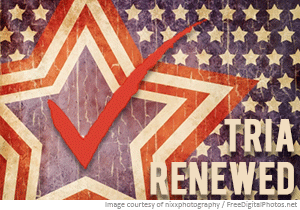
As shown by news reports from France last week, terrorism continues to be a real threat.
Perhaps this reminder prompted the U.S. House of Representatives to vote 416-5 on Jan. 7, 2015 followed by a vote of 93-4 by the U.S. Senate on Jan. 8, 2015 for renewal of the Terrorism Risk Insurance Act (TRIA) through Dec. 31, 2020. President Barack Obama signed the bill, H.R. 26, into law on Jan. 12, 2015.
The renewal of TRIA is welcome news to the insurance industry, including the workers’ compensation line.
In 2002, Congress enacted TRIA following the terrorist attacks of September 11, 2001, in response to terrorism insurance becoming unavailable or, when offered, extremely costly. Extended first in 2005 and again in 2007, the last session of the Senate in 2014 allowed the program to expire on Dec. 31, 2014.
On May 7, 2014, the Rand Corporation announced the release of a new study, “The Impact of Eliminating the Terrorism Risk Insurance Act on Workers’ Compensation Insurance Markets.”
The study noted that losses in workers' compensation could be “more than $10 billion from a large conventional attack (10-ton truck bomb) and more than $300 billion from a nuclear attack.” The study noted that the workers’ compensation losses caused by the 9/11 attacks were “approximately $2.6 billion (in 2013 dollars).”
This study pointed out that because workers’ compensation coverage is mandatory for most employers and defined by each state’s statute, strategies available for other lines of insurance such as changing the insurance contract; imposing policy limits; excluding coverage of terrorism; or excluding losses from nuclear, biological, chemical or radiological (NBCR) attacks are generally not an option.
According to this report, some of the possible effects of TRIA expiration on workers’ compensation absent a dramatic increase in the provision of affordable reinsurance included:
- A reduction in the amount of workers’ compensation capacity provided by the insurance industry, thus making it harder for businesses to obtain coverage, likely to be most pronounced for large employers, landmark buildings and businesses in dense urban areas
- Redistribution of risk such that the burden of catastrophic losses would be confined within the state that is attacked to a greater extent, whereas TRIA spread those losses across the country
- High-risk businesses paying more for their workers’ compensation coverage and the likelihood that those costs would be passed onto to workers in the form of reduced wages and/or benefits, thereby reducing labor income and economic growth
The bill makes the following changes to TRIA:
- Increases the total loss program trigger total loss amounts, with respect to insured losses, from the current $100 million to $200 million, over five years beginning in calendar year 2016
- Decreases the federal share of the compensation for the insured losses of an insurer during each program year by 1% until it equals 80% of the portion of the amount exceeding the annual insurer deductible
- Over five years, starting Jan. 1, 2016, the mandatory insurance marketplace aggregate retention amount of $27.5 billion is increased by $2 billion each year to $37.5 billion
- For all events, the bill raises the private industry recoupment total from the current 133% of covered losses to 140% of covered losses
- Requires consultation with the Secretary of Homeland Security for certification of an act of terrorism and no longer requires concurrence of the Secretary of State
This legislation also includes the National Association of Registered Agents and Brokers (NARAB II) provision intended to streamline insurance producer licensing on a multi-state basis, which the insurance industry wanted.
It is true that the backstop created by TRIA in 2002 has not been used to date. The dollar amount of damage caused by the Boston Marathon bombing attack in 2013, the most serious terrorism incident in the U.S. since 2001, was not large enough to meet the U.S. Treasury's threshold of at least $5 million in property and casualty claims in conjunction with certification. However, TRIA has been credited for providing important stability for the commercial insurance and real estate markets against another terrorist attack.
TRIA is one more of those things that it is “Better to have and not need, than to need and not have.”
Desiree Tolbert, Director, National Technical Compliance